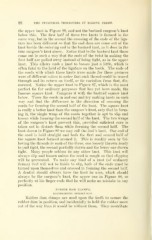Page 208 - My FlipBook
P. 208
88 THE TECHNICAI, PROCEDUEES IK FILLING TEETH.
the ujiper knot iu Figure 88, and not the bastard surgeon's knot
below this. The first half of these two knots is formed in the
same way, but in the second the crossing of the ends of the liga-
ture has been different so that the end does not come out of the
knot beside the entering end in the bastard knot, as it does in the
true surgeon's knot above. Notice that in the bastard knot these
come out in such a way that the ends of the twist in making the
first half are pulled away instead of being tight, as in the upper
knot. This allows such a knot to loosen just a little, which is
often fatal to the hold of the ligature on the tooth. The ends of
the cords with which these knots were made for these pictures
were of different colors in order that each thread could be traced
through and its return on itself, or its variation from that, dis-
covered. Notice the upper Imot in Figure 87, which is the most
perfect tie for ordinary purposes that has yet been made, the
famous square Icnot. Compare it with the bastard square knot
below. Trace the cords in and out and try making Imots in each
way and find the difference iu the direction of crossing the
cords for forming the second half of the knot. The square knot
is really a better knot than the surgeon's knot, only that in form-
ing it, the single wrap of the cords together is apt to slip and
loosen while forming the second half of the knot. The two wraps
of the surgeon's knot prevent this, provided sufficient care is
taken not to disturb them while forming the second half. The
knot shown in Figure 89 we may call the fool's knot. One end of
the cord is held straight and both the first and second half of
the square knot formed around it. This is readily seen by fol-
lowing the threads in each of the three, one loosely thrown ready
to pull tight, the second partially drawn and the lower one drawn
tight. Many people seldom tie any other knot. This knot will
always slip and loosen unless the coi'd is rough so that slipping
will be prevented. To make any kind of a knot (of ordinary
forms) that will not be liable to slip, both of the ends must be
turned upon themselves and crossed in forming the second half.
A dentist should always have the knot he uses, which should
always be the surgeon's knot, the upper one in Figure 88, so
perfectly at his finger-ends that he will make no mistake in any
position.
ETJBBEB DAM CLAMPS.
ILLUSTRATIONS: FIGURES 0()-99.
Rubber dam clamps are used upon the teeth to secure the
rub])er dam in position, and incidentallj' to hold the rubber more
out of the way than it would be without them. They contribute


